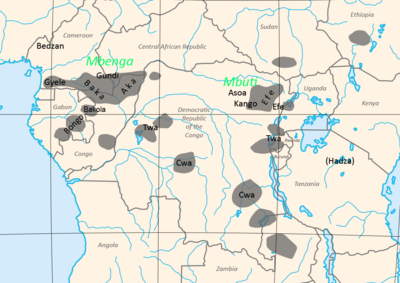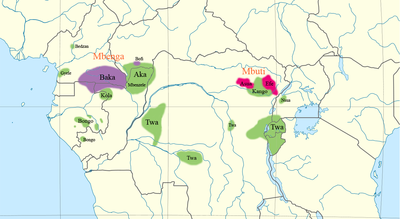Classification of Pygmy languages

The Congo Pygmies (African Pygmies) are those "forest people" who have, or recently had, a deep-forest hunter-gather economy and a simple, non-hierarchical societal structure based on bands, are of short stature,[note 1] and have a deep cultural and religious affinity with the Congo forest[note 2] and live in a generally subservient relationship with agricultural "patrons".
However, these peoples are not related to each other as Pygmies either ethnically or linguistically. Genetically, different Pygmy peoples have distinct mechanisms for their short stature, and demonstrate diverse origins.
Original Pygmy language(s)
An original Pygmy language has been postulated for at least some Pygmy groups. Merritt Ruhlen writes that "African Pygmies speak languages belonging to either to the Nilo-Saharan or Niger–Kordofanian families. It is assumed that Pygmies once spoke their own language(s), but that, through living in symbiosis with other Africans in prehistorical times, they adopted languages belonging to these two families."[1] The linguistic evidence that such languages existed include Mbenga forest vocabulary which is shared by the neighbouring Ubangian-speaking Baka and Bantu-speaking Aka (although not by the Mbuti) and the Rimba dialect of Punu which may contain a core of non-Bantu vocabulary;[2] It has been postulated that ancestral speakers may have been part of a complex of non-Pygmoid languages of hunter-gatherer populations in Africa whose only surviving descendants today mostly ring the rainforest.[3]
A common hypothesis is that African Pygmies are the direct descendants of the Late Stone Age hunter-gatherer peoples of the central African rainforest who were partially absorbed or displaced by later immigration of agricultural peoples and adopted their Central Sudanic, Ubangian and Bantu languages. While there is a scarcity of excavated archaeological sites in Central Africa that could support this hypothesis,[4] genetic studies have shown that Pygmy populations possess ancient divergent Y-DNA lineages (especially haplogroups A and B) in high frequencies in contrast to their neighbours (who possess mostly haplogroup E).[5]
Some 30% of the Aka language is not Bantu, and a similar percentage of the Baka language is not Ubangian. Much of this vocabulary is botanical, and deals with honey collecting or is otherwise specialized for the forest and is shared between the two western Pygmy groups. It has been proposed that this is the remnant of an independent western Pygmy (Mbenga or "Baaka") language. However, this split was only reconstructed as far as the 15th century.[6][7]
Peoples and languages


There are over a dozen attested Pygmy peoples[note 3] numbering at least 350,000 in the Congo Basin. The best known are the Mbenga (Aka and Baka) of the western Congo basin who speak Bantu and Ubangian languages; the Mbuti (Efe et al.) of the Ituri Rainforest, who speak Bantu and Central Sudanic languages, and the Twa of the Great Lakes, who speak Bantu Rwanda-Rundi. All attested Pygmy peoples speak languages from these three language families, and only three peoples, the Aka, Baka, and Asua, have their own language.
Bedzan
Medzan (Bedzan) live in Cameroon not far from the Nigerian border. They speak a dialect of Tikar, a Bantoid language.
- Population: 400
Mbenga
- The Aka of the Central African Republic and the Republic of Congo speak Aka (Yaka) which is a Bantu language close to Lingala. The Benzele Aka are well known for their music.
- Population: 30–50,000
- Miyaka (N Gabon, Bantu), Luma (N Gabon, Bantu) appear to be Aka (Benzele) groups.[citation needed]
- The Baka AKA Ngombe of Cameroon and Gabon speak closely related Ubangian languages of the Ngbaka branch: Baka proper, Ganzi, and Gundi AKA Ngondi.
- Population: 30–40,000
- In the Central African Republic north of the Aka are a group who speak the language of their neighbors, Bofi, which is a language of the Gbaya branch.
- Population: 3,000
- The Gyele AKA Kola or Koya are the westernmost Pygmies, living in southern Cameroon near the coast, and in Equatorial Guinea on the coast. They speak two dialects of the Bantu Mvumbo language.
- Population: 4,000
- Population: 2,600
- Bongo, or Akoa, of southern Gabon speak several Bantu languages, including Tsogo, Nzebi, West Teke, Punu, Lumbu, Myene, Kaningi, and perhaps others such as Yasa.[clarification needed] The Punu dialect of the Irimba, however, may have a non-Bantu core.
- Population: 3,000
Mbuti
- Population: 10,000?
- The Asoa speak their own Central Sudanic language (Asoa),related to Mangbetu, the language of one of their patrons.
- Population: 10,000?
- Population: 26,000?
Twa
The various Twa populations all speak Bantu languages.
- Population: 1,000
- The Great Lakes Twa of the Great Lakes (Rwanda, Burundi, eastern D.R. Congo, southern Uganda) speak Rundi and Kiga.
- Population: 10,000
- The Mongo Twa or Ntomba Twa (Cwa [tʃwa]) of Lake Tumba and Lake Mai-Ndombe of western D.R. Congo, speak several varieties of Mongo (Konda, Ntomba, and Lia), which are either divergent dialects or closely related languages.
- Population: 14,000
- The Kasai Twa or Kuba Twa (Cwa) of Kasai (central D.R. Congo) speak Bushong.
- The Mbote Twa (Bambote) northwest of Lake Tanganyika speak a D20 language.[note 4]
- The Upemba Twa or Luba Twa (Cwa) of the Upemba Depression speak Luba-Katanga, Hemba, Songe, and Taabwa.[8][citation needed]
- The Bangweulu Twa of Bangweulu Swamps, Zambia, speak Bemba.
- The Lukanga Twa of the Lukanga Swamp, Zambia, speak Lenje.
- The Kafwe Twa of the Kafue Flats, Zambia, speak Tonga.
- The Twa of Angola live among the Ngambwe, Havakona, Zimba and Himba, and presumably speak their languages.
Physically, these southern Twa do not differ from their Bantu neighbors, but have a similar subservient position to their agricultural neighbors as the forest Pygmies. They may be remnant Khoisan populations; the Ila, Tonga, and Lenje of Zambia, and the Chewa of Malawi, for example, believe them to be aboriginal peoples, and trace sacred places to them, but Blench suggests that they may have instead migrated from the forest with the Bantu, and were later conflated with aboriginal populations in legend.[9]
However, Roger Blench (1999)[10] argues that the Pygmies are not descended from residual hunter-gatherer groups, but rather are offshoots of larger neighboring ethnolinguistic groups that had adopted forest subsistence strategies.
Bibliography
The most complete account of Pygmy languages is found in Serge Bahuchet (1993) Histoire d'une civilisation forestière, volume 2.
Notes
- ^ Generally speaking; those who are not particularly short, such as the Babongo and Bedzan, are sometimes distinguished as "pygmoid".
- ^ Apart from those who live in the savannah or mixed terrain, such as the Bofi and Bedzan.
- ^ There are other, undocumented hunter-gatherer forest peoples such as the Mbati and Bolimba of the Central African Republic, and there are thought to be more in the two Congos and in Angola.
- ^ Holoholo is in approximately the right location
References
- ^ Ruhlen, Merritt. The Origin of Language: Tracing the Evolution of the Mother Tongue. John Wiley & Sons, Inc: New York, 1994. p. 154
- ^ "DDL : CLHASS - Themes and actions". www.ddl.ish-lyon.cnrs.fr. Retrieved 2017-01-22.
- ^ Blench, Roger. 1997. "The languages of Africa". In Blench & Spriggs (eds.), Archaeology and language IV
- ^ Bahuchet, Serge (2 January 2012). "Changing Language, Remaining Pygmy". WSU Press. p. 28.
- ^ Naidoo, Thijessen (2014). "PHYLOGEOGRAPHY OF Y CHROMOSOME HAPLOGROUPS A & B IN AFRICA" (PDF). p. 90.
- ^ Serge Bahuchet, 1993, History of the inhabitants of the central African rain forest: perspectives from comparative linguistics. In C.M. Hladik, ed., Tropical forests, people, and food: Biocultural interactions and applications to development. Paris: Unesco/Parthenon.
- ^ Bahuchet, Serge (Aug 2006). "Languages of African rainforest " pygmy " hunter-gatherers: language shifts without cultural admixture. Historical linguistics and hunter-gatherers populations in global perspective" (PDF). Max-Planck Inst., Leipzig. p. 22.
- ^ Kazadi 1981:838 reports the Cwa were living with the Luba when they moved south and contacted the Hemba. (Méprisés et admirés: l'ambivalence des relations entre le Bacwa (Pygmées) et les Bahemba (Bantu). Africa 51-4.)
- ^ Blench, Roger. 2004. Genetics and linguistics in sub-Saharan Africa. Presented at SAfA 2004.
- ^ Blench, Roger. 1999. Are the African Pygmies an ethnographic fiction? In: Central African hunter-gatherers in a multi-disciplinary perspective: challenging elusiveness. K. Biesbrouck, S. Elders & G. Rossel eds. 41-60. Leiden: CNWS.
- Serge Bahuchet, 2006. "Languages of the African Rainforest « Pygmy » Hunter-Gatherers: Language Shifts without Cultural Admixture."[1] In Historical linguistics and hunter-gatherers populations in global perspective. Leipzig.
- Hewlett & Fancher, 2011. "Central African Hunter-Gatherer Research Traditions". In Cummings, Jordan, & Zvelebil, eds, Oxford Handbook of the Archaeology and Anthropology of Hunter-Gatherers. Oxford University Press
